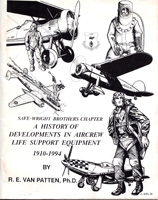 |
Van Patten,
R.E., Ph.D.: A History of Developments In Aircrew Life Support
Equipment 1910-1994. Private publication, for the SAFE Association
Wright Brothers Chapter, R.E. Van Patten, Bellbrook, OH, 1994. No ISBN, 76 pages. The book covers three areas; ejection seats, high altitude life support equipment, and anti-g suits and valves. The book is crammed with interesting facts as could be expected taking the author's background into consideration. He spent 26 years at the USAF Aerospace Medical Research Laboratory (1963-1989). Unless I totally misunderstand the term "extended coverage anti-g suit" I find it slightly disappointing that he states that the extended coverage anti-g suit pioneered by the 1947-vintage G-4 suit was not developed further until the 1980s and that none had reached operational status by 1994. If an extended coverage anti-g suit is a combined flying suit and anti-g suit, both the G-4A, G-4B and MB-2 were used by USAF in the 1950s and the US Navy used the Z-2. Apart from this possible weak point, the book is interesting and recommendable.. |
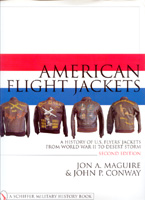 |
Maguire, Jon A. and Conway, John P.: American Flight Jackets, A History of U.S. Flyers' Jackets From World War II To Desert Storm. Second Edition. Schiffer Publishing Ltd., Atglen, PA, USA, 2000. ISBN 0-7643-1065-8. 280 pages. |
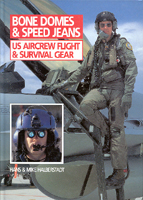 |
Halberstadt, Hans &
Mike: Bone Domes & Speed Jeans, US Aircrew Flight & Survival Gear.
Windrow & Green Publishing. London, 1996. ISBN 1-85915-081-0. 128 pages. Bone Domes & Speed Jeans takes a snapshot at current flight gear at the time of publishing in USAF, US Navy and US Marine Corps. As a very refreshing initiative it includes information about the US Coast Guard and Parachute Jumpers - both areas somewhat overlooked when discussing flight gear. It also has a chapter on the pressure gear used by NASA for flights in the Lockheed ER-2 reconnaissance plane. The text is not attempting to convey information about flight gear in any great detail but the book is crammed with high quality colour pictures. |
 |
Spaziani, Alberto: Caschi
Da Volo Radiotelefonici Della Regia Aeronautica, Regia Aeronautica
Radiotelephonic Flying Helmets. IBN Editore, Italy, 2002. ISBN .... 62 pages The book covers flying helmets used by the Italian Regia Aeronautica (Royal Air Force) up to 1946. I have not seen the book myself but the author Alberto Spaziani is renowned for being an expert on Italian flightgear. I would not hesitate to buy the book if I needed information on WWII Italian flying helmets, especially since it has both Italian and English text. |
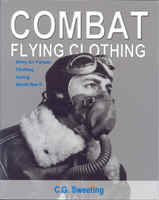 |
Sweeting G.C.: Combat Flying Clothing, Army Air Forces Clothing During World War II. Smithsonian Institution Press, Washington D.C., 1984. ISBN 0-87474-898-4 (cloth), 1-56098-503-8 (paper). 158 pages. If you want to know about the development of USAAF flying clothing before and during World War II this is the book! The author was the curator of flight materiel at the National Air and Space Museum for 15 years. Through his job he had access to a large amount of archive material and it shows. The book is illustrated with black-and-white photographs only and that is its weakest point. As luck would have it it does not matter so much. They are available in abundance in Jon Maguire’s book Gear Up! (see review below). The two books together form a very comprehensive reference to USAAF flying clothing. One trifling error in Sweeting’s book should be mentioned; on page 88 he mentions that HS-38 was the standard radio headset used by the AAF during WWII and a picture on page 89 is purportedly showing one. The picture shows an HS-33 headset and it was not introduced until 1943. |
 |
Sweeting G.G.: Combat
Flying Equipment, U.S. Army Aviators' Personal Equipment, 1917-1945. Smithsonian
Institution Press, Washington D.C., 1989. ISBN 0-8747-894-1 (hbk), 1-56098-502-X (pbk).
244 pages. The book is describing the development of US Army aviators' personal
equipment 1917-1945, and it is a companion volume to the book Combat Flying
Clothing by same author (see the review above). Even if you are not collecting
WWII gear the book would still be of interest. The developments made during that period
are the basis of the gear we see today. A prime example is the A-13 oxygen mask which to
all intents and purposes is the same as the MS22001 mask used until recent years by a
large number of air forces. The book will give you information about oxygen systems, parachutes, anti-g equipment, pressure suits, armour, survival equipment and miscellaneous (watches, signal pistols, first aid kits etc.) |
 |
Robinson, Douglas H.: The Dangerous Sky, A History of Aviation Medicine. University of Washington Press, Seattle, WA, USA, 1973. ISBN 0-295-95304-7. 292 pages. The book is describing the history of aviation medicine. It does not contain much information about specific flightgear but gives valuable explanation of all the physiological factors that make much of the flightgear necessary. Unless you are really hooked on the medical side of things I would recommend Into Thin Air as an alternative as it contains a mixture of medical and gear-specific information. |
 |
Tuttle, Jim: Eject!
The Complete History of U.S. Aircraft Escape Systems. MBI Publishing Company, St.Paul, MO,
USA, 2002. ISBN 0-7603-1185-4. 256 pages. Eject! gives a historical rundown of U.S. aircraft escape systems including ejection seats and escape capsules. It ends with the Cirrus parachute system meant for saving an entire light aircraft. The book is somewhat disappointing. It would have been more fair to label it 'Stories about US Escape Systems' than 'The complete history...' The book is filled with personal accounts of people 'who were there' but lacks in technical detail about the different systems. IMHO a 'complete history' should have had more drawings and diagrams etc. explaining the development and relative merits of each development stage. I was disappointed to see obvious omissions - the unique early Weber rotating seat design for the F-106 is not included at all. Members' comments on "Eject!" |
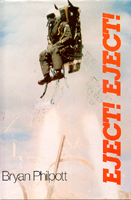 |
Philpott, Bryan: Eject! Eject! Ian Allan Ltd., Shepperton, UK 1989. ISBN 0-7110-1804-9. 160 pages. |
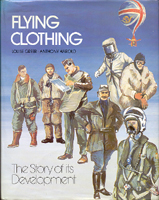 |
Greer, Louise and Harold,
Anthony: Flying Clothing, The Story of its Development. Airlife
Publishing Ltd., Shrewesbury, UK, 1979. ISBN 0-9504543-7-0. 176 pages. Flying Clothing is giving a general overview of the development of flightgear since the early balloonists. It is recommended as background reading for someone who would like to find out how it all began but it does not meet the expectations of a hardcore collector who wants to find technical details about his latest piece of gear. That said there are some very useful snippets of information about and pictures of specific British flightgear. One such item is the elusive Mk.1 helmet visor which was the first step in the development from goggles to visors fixed to the helmet shell. |
 |
Weld, Jim: Flying Headgear of The World 1934-1945. Jim Weld, Huntingdon Beach, CA, USA, 1980. ISBN 0-9603240-0-3. 50 pages. My first book on WWII headgear, it provides a useful visual reference to helmets, oxygen masks and goggles of the inter-war years and WWII. Whilst it does not come anyway near Mick Prodger's Vintage Flying Helmets it is still a good supplement, and if you are temporarily short of cash it is a good investment while you are saving for Prodger's book. |
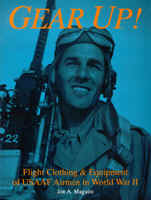 |
Maguire, Jon A.: Gear Up! Flight Clothing & Equipment of USAAF Airmen in World War II. Schiffer Publishing Ltd., Atglen, PA, USA, 1995. ISBN 0-88740-744-7. 184 pages. This book gives an overview of the flight clothing and equipment used by USAAF crew in the WWII. Crammed with a mix of period black-and-white and current colour photograps, it constitutes a comprehensive visual reference and a valuable supplement to C.G. Sweeting's book Combat Flying Clothing (see above). Like in that book, a few minor errors have found their way into Gear Up! concerning headsets. Easily distinguishable by its red PL-354 plug, an HS-33 headset is shown on page 45 but the caption says HS-18. The different headset types are explained on page 13 but the author mixes up the designations HS-18 and HS-23. The former was used for helmets and the latter with a headband but he explains it the other way around. |
 |
Gibson, T.M. & Harrison, M.H.: Into Thin Air, A History of Aviation Medicine in the RAF. Robert Hale Ltd., London, UK, 1984. ISBN 0-7090-1290-X. 279 pages. Extract of Chris "DocBoink" Carey's review on Into Thin Air, "Whilst ostensibly a history of aviation medicine in the RAF, this is also the story of RAF life support equipment. It has extensive historical background on the development of RAF oxygen breathing equipment (masks, etc.), flight protective clothing, pressure suits, anti-G garments, personal flotation devices (PFDs), egress systems (E-seats), and far more. At 279 pages length & simply packed with valuable information and photographic images, this book is basic reference material for any serious student of aerospace life support technology. It is particularly useful in that it paints both a broad and precisely focused picture of the important early contributions made by UK researchers in the field of both aviation medicine and the life support sciences". Read the full review |
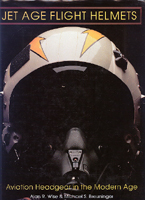 |
Wise, Alan R. &
Breuninger, Michael S.: Jet Age Flight Helmets, Aviation Headgear in the
Modern Age. Schiffer Publishing Ltd., Atglen, PA, USA, 1996. ISBN 0-7643-0070-9. 248 pages.
Jet Age Flight Helmets, or JAFH for short, contains a fine selection of colour photos of
flight helmet from 1950 and onwards. Most are US helmets but the book also contains a
section on non-US helmets. Lacking a bit in hard facts, the book is described as "a
photographic chronicle of jet age and space headgear" and as such it is highly
recommended for helmet collectors. Quite a bit of information is contained in photo
captions but they are marred by a number of errors. The book is also lacking an index for
quick reference. This should not keep you from buying it, the old flightgear group
compiled an errata and an index that you can download via the links below. MSWord format JAFH errata JAFH index RTF-format JAFH errata JAFH index |
 |
Prodger, Mick J.: Luftwaffe vs. RAF, Flying Clothing of the Air War, 1939-45. Schiffer Publishing Ltd., Atglen, PA, USA, 1997. ISBN 0-7643-0234-5. 158 pages. |
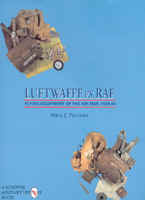 |
Prodger, Mick J.: Luftwaffe vs. RAF, Flying Equipment of the Air War, 1939-45. Schiffer Publishing Ltd., Atglen, PA, USA, 1998. ISBN 0-7643-0249-3. 148 pages. |
 |
|
 |
Breuninger, Mike S.: United States Combat Aircrew Survival Equipment, World War II To The Present, A Reference Guide For Collectors. Schiffer Publishing Ltd., Atglen, PA, USA, 1995. ISBN 0-88740-791-9. 202 pages. |
 |
Prodger, Mick J.: Vintage Flying Helmets, Aviation Headgear Before The Jet Age. Schiffer Publishing Ltd., Atglen, PA, USA, 1995. ISBN 0-88740-776-5. 336 pages. The ultimate treatise on inter-war and WWII headgear! It is as simple as that. The must-have reference if you are even remotely interested in flight gear from that era. It really isn't necessary to say more about it but if you insist, it has comprehensive information on the history of the different pieces of headgear and is lavishly illustrated with colour pictures. |
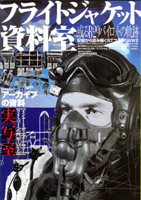 |
|